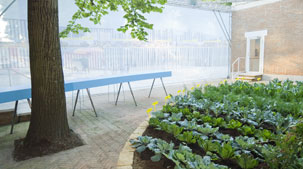about the exhibit
overview
on view
public programs
projects
participants
images
multimedia
design
organizers
sponsors
credits
press info
Architecture in the United States has lurched back and forth between social engagement and passivity since at least 1932.
That was the year the Museum of Modern Art presented Modern Architecture: International Exhibition, which highlighted--or, according to some critics, triggered--a split within the field. Conceived by historian Henry Russell Hitchcock, architect Philip Johnson, and MoMA director Alfred Barr, the exhibition presented modern architecture as a new style that resulted from the evolution of form, instead of social conditions such as a need for low-cost, mass-produced affordable housing. The white walls, flat roofs, and rejection of ornament in the work of architects such as Ernst May, as depicted in the MoMA show, presented modern architecture as an aesthetic style--an abstract form in a landscape, photographed aerially and devoid of social relations. Arguably, the position espoused by Johnson, Hitchcock, and Barr defined the profession in North America from that time onwards. Iconic buildings, formalism, and a myopic obsession with the upper class: these became the hallmarks of much American architecture.
Today, changing populations, shifting borders, and uneven economic development--exacerbated by the explosion of migration and urbanization--have generated conflicts and conditions that question traditional architectural methods. In a milieu characterized by territorial and institutional deadlock, architects, urban researchers, and community activists increasingly must intervene in situations by "going beyond building." This does not mean dispensing with the value of architecture per se, but rather acknowledging each situation's unique complexity as the generative idea. This exhibition explores the original ways that today's actors are designing the conditions from which new architectures can emerge. They are becoming activists, developers, facilitators of inclusive urban policies, as well as unique urban researchers. Their work expands upon diverse alternative practices of the 20th century, including the urban reformers of the Regional Planning Association of America, the research-based designs of Charles and Ray Eames, the humanistic modernism of Hassan Fathy, and the experimental installations of Art Farm.
We are also proposing that social, cultural, and spatial boundaries that characterize the American landscape be understood as a new framework defining architectural problems. Accordingly, we have identified a heterogeneous and dispersed series of practices that are empowered by the inventive ways they work and with whom they engage. These intellectually entrepreneurial practitioners are reaching creatively across institutions, agencies, and jurisdictions to negotiate hidden resources in the private, public, and non-profit sectors to invigorate social activism and environmental policy.

In the absence of large-scale public infrastructure projects in the United States, local initiatives are necessarily becoming empowered, dynamic arenas for exploring and generating new forms of sociability and activism. We hope this preliminary showcase of America's alternative architectural practices acts as a stimulus that encourages new forms of social participation to flourish beyond our current imaginings.
With a little knowing irony, we like to label Into The Open: Positioning Practice, which opened in September 2008 in the United States Pavilion at La Biennale di Venezia, "the first architectural endeavor of an Obama presidency." Setting aside the fact we were commissioned by the U.S. State Department under George W. Bush, and that the exhibition opened some weeks before November's election, we believe that the present moment will redefine the meaning of social space in today's American cities and neighborhoods. With Obama's new mandate in the U.S. election and the current world wide financial crises acting as forceful agents for change, maybe the stars are finally aligning in a propitious way. Perhaps they will force architecture to mitigate its current celebrity obsessed approach, encouraging instead a new type of collaborative thinking about design and space that highlights local, periphery, and even edge conditions.
To remain relevant, architecture must find ways to respond to the cultural fluidity, socio-economic challenges, and environmental rifts that define our times.
